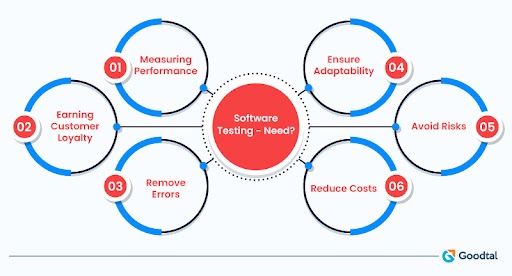
As a business planning for software development, you must have heard a lot about software testing and its need. Too much information is confusing and can also create a panic situation. So, this blog aims to present software testing simply and quickly to help you understand the concept, needs, and challenges of software testing.
Let’s start!
Why Do We Need Software Testing?
Software testing aims at bridging the gap between the actual and the expected results from software development. It ensures that the delivery meets the expectations, requirements, and needs. The best software testing service providers deliver error-free, high-performing software that efficiently serves the purpose to generate revenue and bring customer loyalty.
The infographic here lists why software testing is important.

Evolution of Software Testing
Software testing has existed for decades now. However, it has advanced from primitive post-development functional testing to continuous and integrated testing while writing the code and continues till the end of the development process. Does it mean it stops after the release of the software? No, in this competitive era, the software must continue to update even after release and so we need to continue testing even after release.
It sounds complicated that the software developers must manage testing along with development at all stages but this is not how it works. Software testing is now a separate field managed by highly specialized professionals who are experts in testing. They work along with the developers to guide and execute testing at all stages.
Software development is a multi-level and multi-stage process covering several aspects of building completely functional software from scratch. As also depicted by the above infographic, software testing starts from the initial stages of development to ensure that no time is wasted on errors generated at this stage.
Software testing does not end even after the software achieves customer loyalty as it is required to sustain the customers. Summarily, testing is a never-ending process for successful software.
Software Testing- Stages & Types
We can gather from the above that software testing is continuously integrated from the beginning to the end of software development. One thing was common to all the stages of evolution, i.e., the aim of software testing, which is to ensure that the stage serves its purpose efficiently.
For specific management, software testing is bifurcated into different stages, each serving its purpose and passing on the results to the next. Some stages can run in parallel as well. The crucial stages of software testing are requirements analysis, planning, test case development, environment setup, execution, and reporting.
Now, coming to the types! Software testing broadly includes both functional and non-functional tests. Each of these further has sub-categories. The infographic here lists the different types of testing services.

Most of the terms above make the purpose of the test clear. For example, usability testing is to check whether the software complies with the intended use.
Software Testing - Tools
As software testing evolved into a huge domain, various tools were developed to manage the different aspects of testing. Some of these tools are specific to specific areas of testing while the more advanced tools cover software testing widely.
Selenium and Apache JMeter are some of the most popular software testing tools offering a user-friendly interface, and ease of testing. Here are the characteristics of each.
Selenium
The main reason why software testing experts prefer Selenium is that it supports different operating systems. Also, almost all browsers recognize Selenium scripts. It is a browser focussed tool that supports various languages such as Java, Python, Ruby, HTML, etc. It is commonly used for functional testing. Selenium can be used for mid or large-sized projects. There are loads of benefits of using Selenium. However, there is a limitation too; it does not allow developers to write custom tests.
Suggested Reading: 3 Best Tools for Software Testing & Quality Assurance
Apache JMeter
It is an open-source, free, cross-platform, performance testing tool. It is used for a variety of services, such as Web services, FTP services, Messaging Oriented Services, etc. JMeter is a server focussed testing tool that supports mainly Java language. It offers distributed load testing. It also allows developers to write custom tests.
The main limitation of JMeter is that it is not scalable. And, it is not very easy for beginners. It allows limited real-time testing options and doesn’t offer cloud adoption.
Another most commonly used software testing tool is Microsoft Test Manager. It covers a very wide range of testing needs.
When discussing software testing, we must not ignore the common challenges that can act as roadblocks. If we prepare in advance, we can overcome them.
Challenges in Software Testing
Time Constraint
In the early stages of software or app development, many basic proficiency developers used to ignore software testing due to a shortage of time and money. With time, developers realized that the time saved without testing was nothing compared to that wasted in correcting the post release software performance. This gave rise to the concept of continuous testing which is now almost a norm among the top software developers. They know the value of software testing and so they ensure that enough time is spent on various stages of testing.
Clients define the deadlines and so it becomes challenging for developers to accommodate development and testing in the same time frame. The only solution to this is that the clients realize the value of quality software and reserve enough time for software testing. However, this is possible when the development partners communicate well with the clients and discuss it even before development starts.
Poor Communication
Poor communication is one of the biggest bottlenecks in software development or testing. It starts right from the user requirements stage to market research and continues to the development and testing stages. The communication problem can be between the client to the service provider or internally among the software testing teams.
In the former case, comprehensive user requirements documentation and multiple sessions of client-to-developer communication can solve the communication issue. It is also essential that professionals good at communication, apart from those having technical skills are put in client communication roles.
Internal communication issues also make it difficult for software testing providers to deliver the best. There is often a dilemma as to what stage or level of testing requires more time and resources. However, for software testing professionals who have rich experience in managing challenging projects, this is easy to manage. The others learn with time and after making mistakes.
Poor Documentation
Incomplete or poor documentation is a serious hindrance to successful software development and software testing. Poor documentation in testing leads to a wrong understanding of the scope of tests and wasting time in testing on a trivial aspect while ignoring the critical areas. Thus, software developers and testers must ensure that the documentation is accurate and covers all the essentials.
Diverse OS & Devices
Software testing has to incorporate the needs of a wide range of OS and devices. This is a very big challenge and never-ending as the testing continues post-launch and the software should perform in all changing needs, safety requirements, and challenges.
Real-time live software environment is generally different from the best or worst that you can perceive during the simulation and there are unexpected circumstantial issues that can cause the software to malfunction. However, software testing experts cannot use it as an excuse and they must prepare for the unexpected too.
Dynamic Environment
Software and app undergo continuous transformation to adapt to the changing user needs. So, the tried and tested software testing tools, practices, and strategies when outdated may not work with the new environment. Thus, software testing professionals need to continuously keep themselves updated and acquire new skills. They also need to keep up with the emerging trends in software testing so that they can cope with all the new challenges coming their way.
Suggested Reading: Are You Keeping Up With the Emerging Trends in Software Testing?
Specialized Skills
High-quality specialized software testing was a big challenge till a few years ago. Though to some extent, it still is. However, now with some specialized software testing companies taking charge of the situation, you can expect that your software testing is in the safe hands who have the right experience, expertise, skills, and tools to get you the best software testing results.
The next challenge then is to identify such software testing agencies that can deliver the best results.
Wrapping Up!
By now you would be convinced that software testing is not just important, but compulsory for successful software. We have also discussed the most popular software testing tools that will help you save time with efficient testing.
The challenges mentioned above will prepare you for any possible hindrances. However, software testing is vast and complex. And so, it is recommended that you fulfill your software testing needs by hiring the best testing services that match your needs. The list of software testing services by Goodtal will help you identify the right software testing partners. Don’t forget to check it!
